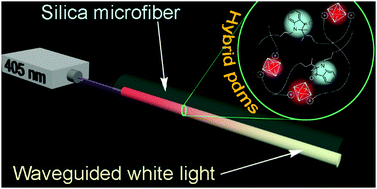Poly(dimethylsiloxane) functionalized with complementary organic and inorganic emitters for the design of white emissive waveguides†
Abstract
Multifunctional hybrid materials made of organic and inorganic emitters embedded in an organic polymer are candidates of choice to design active waveguides for optoelectronic devices or optoelectronic applications. We describe in this work the integration of a blue green emissive organic 3-oxindole and/or a red-NIR phosphorescent octahedral molybdenum cluster in a poly(dimethylsiloxane) host matrix. Photophysical investigations show the existence of energy transfers between the emitters in the nanocomposite whose efficiency depends on the irradiation power and as a result on the oxygen concentration dissolved in the host matrix. Such properties understood, the hybrid has been copolymerized in a silica microfiber to design active waveguides. Irradiation at one end of the microwire leads to a white emission guided along the fiber, of particular interest for optical sensing, optical coherence tomography or telecommunications.



 Please wait while we load your content...
Please wait while we load your content...